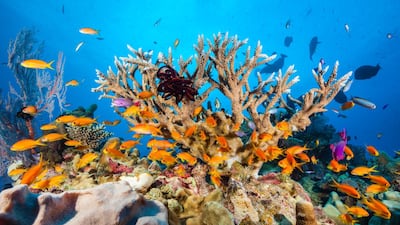New research has shown how some coral reef species are able to tolerate periods of extra-warm temperatures, bringing hope that some reefs may survive the increasing rises in global sea temperatures.
But scientists have warned that the more resilient corals may be less able to support a diverse community of other marine species.
Carried out in the British Indian Ocean Territory, an area south of the Maldives that includes the Chagos Archipelago, the new study found that an eight-week heatwave in 2015 killed 60 per cent of hard corals at depths of up to 10 metres.
The following year another hot spell, lasting four months, killed 29 per cent of the coral that remained in an area called the Peros Banhos Atoll – a much smaller proportion than died the previous year, although other coral was left bleached. The two heatwaves together killed about 70 per cent of the hard corals in the region.
Published in the journal Coral Reefs, the findings came from surveys of the seafloor taken before and after the periods of hot weather.
“It is encouraging that a relatively low percentage of corals perished from the second heatwave, as it was extremely long in duration,” said Dr Catherine Head, of the Zoological Society of London’s Institute of Zoology.
“This suggests that some corals do have some natural resilience to hotter conditions.”
The 2015 heatwave wiped out the less heat-tolerant species and left behind forms better able to deal with high temperatures.
Among the more vulnerable types was the most abundant coral in the area, the Acropora species, of which 86 per cent were killed in the first heating period.
Research into how some species can tolerate high temperatures could highlight ways in which coral reefs could be protected from climate change, suggested Dr Head.
Dr John Burt, an associate professor of biology at New York University Abu Dhabi, who was not connected with the Indian Ocean study but who has researched UAE corals, said there are downsides when more heat-tolerant species are left behind.
“We are seeing shifts in the community structure from more sensitive species to more robust species in many areas of the world over time as we lose the more sensitive species, but the problem is we’re doing this at the expense of diversity,” he said.
“We end up, yes, with a community that is more resistant to future bleaching events, but doesn’t support the same ecosystem that was there a few years ago, aside from the fact that you’re losing a significant amount of coral cover.”
He said the heat-sensitive Acropora species, some of which are known as table corals because they spread out like tables, are particularly good at supporting other species.

Also, the more heat-tolerant species tend to be slower-growing, so regeneration after a period of unusually hot weather can be very slow.
In previously reported research, Dr Burt found that more than 90 per cent of Abu Dhabi's 120 square kilometres of coral cover was bleached by record temperatures in the summer of 2017. By April 2018, almost three-quarters of the coral had died.
As was the case in the BIOT, it tended to be more heat-tolerant species that were left behind.
A reef is made up of colonies of coral polyps that secreted calcium carbonate skeletons to support and protect the coral. The polpys live in a mutually beneficial relationship with the algae they shelter in return for energy produced through photosynthesis.
Coral bleaching results from the way that high temperatures affect the relationship between the coral and the algae.
In warmer temperatures, the algae photosynthesise more, producing more oxygen than the coral tolerate and causing them to expel the algae. This deprives the coral of the glucose and other food that the algae provided.
The coral can live off fat reserves for a time, but if stressful conditions remain, the algae will not be taken back in and the reefs will die.
Dr Head said research into how more heat-tolerant species might help reefs adapt to environmental change, such as through selective breeding, “is under way but is in its infancy”.
“Our study provides data on the effects of recurrent bleaching events on coral reefs, which is critical for assessing the strength and extent of any naturally occurring adaptation mechanisms,” she said.
The Zoological Society of London has carried out work in the BIOT, an area with 55 islands surrounded by 60,000 square metres of coral reefs, for more than a decade.
The organisation said it was often difficult to disentangle the effects on coral of climate change and human activity such as fishing, so looking at the largely undisturbed BIOT reefs was especially useful.
This year, the organisation began a UK-government-funded project to look at the effects of plastic pollution in the area.


